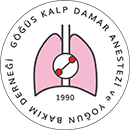

Volume: 18 Issue: 3 - 2012
| EXPERIMENTAL WORK | |
| 1. | Preoperative Variables Predictive For Blood Transfusion in Cardiac Surgery Öznur Mart Bakır, Zeliha Özer, Gülçin Eskandari, Nehir Sucu, Davud Yapıcı, Kürşat Aköz doi: 10.5222/GKDAD.2012.057 Pages 57 - 62 (1757 accesses) OBJECTIVE: To optimize preoperative transfusion strategies and to take necessary precautions, determining the high risk patients for bleeding is important. In this study, it was aimed to investigate immunologic and non-immunologic determinants of the transfusion requirements. METHODS: Thirty three patients were included in the study. In the preoperative period all patients were assessed in terms of immunologic (TNF-α, IL-10), non immunologic-patient depended (age, gender, ejection fraction (EF), Hct, Hb, creatinin and the INR levels) and non-immunologic surgery depended (temperature and Hb levels during cardiopulmonary bypass (CPB) period, CPB duration ) parameters. During the operation, patients were transfused by a target of Hb 7-8 gr/dl, ≥25%Hct and those who were transfused < 2 and ≥ 2 packs of red blood cell were determined. RESULTS: Twenty nine of patients were transfused < 2 pack of red blood cell and 4 of them were transfused ≥ 2 packs. Iimmunologic variables did not correlate with the transfusion amount. The patients transfused ≥ 2 packs of red blood cell perioperatively were determined to have lower Hb, Hct and ejection fraction preoperatively and higher cardiopulmoner bypass duration but this finding was not statistically significiant. CONCLUSION: The results of our study showed that TNF-α and IL-10 levels are not determinants of perioperative blood transfusion requirements. Also, it was not established a statistically important correlation between non immunologic factors and transfusion amounts. Increasing the study patient population for these group of determinants were thought to be beneficial. |
| 2. | Comparison of Thoracic Epidural vs Paravertebral Patient Controlled Analgesia After Donor Hepatectomy Elif Koç, Hüseyin İlksen Toprak, Sibel Aslan, Ülkü Özgül, Canan Kızılyel, Mehmet Özcan Ersoy doi: 10.5222/GKDAD.2012.063 Pages 63 - 67 (1366 accesses) OBJECTIVE: We aimed to compare thoracic epidural vs paravertebral blockade in terms of the relief of postoperative pain in donor hepatectomy. METHODS: 50 patients, aged 18-60 years, ASA I-II undergoing donor hepatectomy operation were enrolled in this study. Patients were randomly allocated into two groups of 25 patients each (Group 1, paravertebral analgesia; and Group 2, epidural analgesia) and either paravertebral or epidural analgesia was applied at the level of T6-8. Postoperative VAS, vital signs, sedation score, overall patients satisfaction, cumulative consumption of local anesthetic, rescue analgesic requirements and side effects were evaluated for 24 hours after surgery. RESULTS: The cumulative local anesthetic consumption in Group 1 was higher when compared with Group 2 at 2 and 4 h after surgery (p<0.05). In group 1, rescue analgesic requirement was higher than in group 2, but the difference was not statistically significant. There was no difference in patient satisfaction between groups. There were no complications except for one patient with nausea and vomiting in each groups. CONCLUSION: Paravertebral analgesia may be a good alternative to thoracic epidural analgesia for postoperative pain control in patients undergoing donor hepatectomy. |
| CASE REPORT | |
| 3. | ISCHEMIC COLITIS AND COLON PERFORATION DEVELOPED AFTER CORONARY ARTERY BYPASS GRAFTING (Case Report) Nedim Çekmen, Özcan Erdemli, Hacer Serdaroğlu, Didem Oğuz doi: 10.5222/GKDAD.2012.068 Pages 68 - 72 (2441 accesses) Frequency of gastrointestinal complication (GIS) after cardiac surgery is rare, and it is associated with high mortality when it is seen. The one with most mortal course in these complications is ischemic colitis. It is known that splancnic hypoperfusion is the main cause in most of gastrointestinal complications. Our case has taken the diagnoses of ischemic colitis and colonic perforation due to it after analyses made due to abdominal distention, pain and failure of gas-gaita excretion, persistent metabolic acidosis, raised lactate level and leukocytosis after CABG (Coronary Artery Bypass Grafting). Surgical treatment, protective pulmonary ventilation, supportive and nutritional therapy were administered to our patient. The patient was lost on 29th postoperative day due to septic shock and multiple organ failure. Detailed analyses should be made and GIS complications should certainly considered on a patient who had cardiac surgery, abdominal distention, pain, failure of gas-gaita excretion and persistent metabolic acidosis. We also aimed to present an ischemic colitis and colon perforation case with accompaniment of literature, which developed after coronary bypass and had mortal course. |
| 4. | Complete atrioventricular block associated with transdermal fentanyl treatment for cancer pain Derya Tok, Aslı Demir, Elif Hande Özcan, Fatih Mehmet Uçar, Kumral Çağlı, Ümit Karadeniz doi: 10.5222/GKDAD.2012.073 Pages 73 - 75 (4706 accesses) Cancer pain management is very substantial in terms of quality of life in patients with end-stage cancer. Transdermal fentanyl patch delivers a constant rate fentanyl from a reservoir which is an effective and practical way for relieving of cancer pain. In this report we present a 78-year-old male patient with end-stage lung cancer whom developing complete atrioventricular block likely due to the fentanyl patch treatment. |
| 5. | A Rare Complication Of The Pulmonary Arterial Catheterization: Migration Of The Catheter Into Venous Canula Within Superior Vena Cava Murat Aksun, Senem Girgin, Ufuk Yetkin, Tayfun Göktoğan, Ali Gürbüz, Nagihan Karahan doi: 10.5222/GKDAD.2012.076 Pages 76 - 78 (1681 accesses) In this case report, we described a patient undergoing open heart surgery due to mitral and tricuspid valve insufficiency, involuntary progress of the pulmonary artery catheter into the venous canula in the superior vena cava and smoothly removal of the catheter after being noticed. In the literature of complications and malpositions there was no case before such notifications has been made. According to us, this case, is extremely important to have sufficient information about pulmonary artery catheterization complications, to solve them and for the prevention of morbidity and mortality. |

















